|
You are in for a real treat with this
review of Pat Nichol's newest reproduction fabric line, as Pat is sharing
swatches of the original antique fabrics used for this line. All antique
fabric collectors know how exciting it is to see the real thing, and then
together side by side with the new version, well it elevates this study to new
level for us. Thank you Pat!
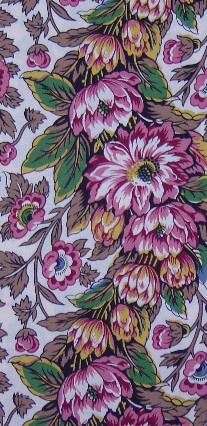 This is a particularly good collection
to purchase for the new reproduction quilters because it has a completeness to
it that isn't often seen in collections. That's not to say the reproduction
companies don't aim for this, because they often do, but often times there is
a similarity in the colors or scale that necessitates the quilter use
additional fabrics. This is not the case in this collection. In fact, there
are many different color combinations that can be made from this one grouping,
using large and small scale prints in each group. I have had fun playing with
all the combinations but decided to introduce them here by design and not the
various groupings. That's up to your creativity. Let it flow with this group,
the fabrics really play off of each other nicely, keeping in mind that early
quilts were very colorful quilts, not drab! In the end you will have a chintz
quilt which can be very scrappy depending on the blocks you chose to make, or
more of a high-style quilt using many of the large scale prints cut into
larger pieces. This is a particularly good collection
to purchase for the new reproduction quilters because it has a completeness to
it that isn't often seen in collections. That's not to say the reproduction
companies don't aim for this, because they often do, but often times there is
a similarity in the colors or scale that necessitates the quilter use
additional fabrics. This is not the case in this collection. In fact, there
are many different color combinations that can be made from this one grouping,
using large and small scale prints in each group. I have had fun playing with
all the combinations but decided to introduce them here by design and not the
various groupings. That's up to your creativity. Let it flow with this group,
the fabrics really play off of each other nicely, keeping in mind that early
quilts were very colorful quilts, not drab! In the end you will have a chintz
quilt which can be very scrappy depending on the blocks you chose to make, or
more of a high-style quilt using many of the large scale prints cut into
larger pieces.
The original fabrics date between 1800
and 1850. There are three large scale prints and five medium to small prints
in such a variety of colors it would be hard to say what, if any, is
predominant. What grabs my attention the most are the polychrome chintz prints
(minimum of 5 colors within the print). The other colors in the group are
shades of blue, green, brown, tan, pink, yellow, and dark red. The colors
range from strong pastels to bold darks. The chintz prints have white or light
grounds and some are patterned. Nicely done too. Your reproduction quilt of a
later period could include these prints in it especially if it is a scrap
quilt. There is a gorgeous large scale border print that also lends itself to
strippy style quilts, which were popular during that time period.
For this review I have adjusted the
scanning of the five smaller prints so they are exact in scale. The three
large prints are very large and have been reduced as necessary to give you a
feeling for the print. I varied the reduction to give you a better idea. I
keep the download time in mind to make these decisions, because I know how
frustrating it can be if download takes too long. This review will require two
or more pages to keep the download time to a minimum.
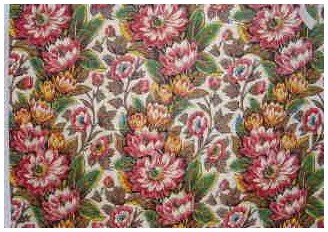
original early 19th
Century chintz
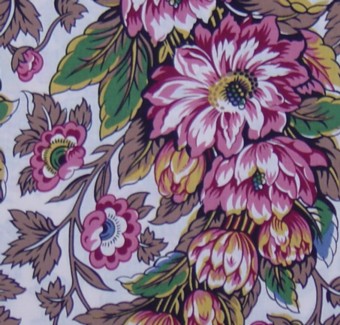 The border print is an English large
floral stripe made during the Exuberance period as a furnishing fabric, about
1840. It would have been roller printed, which was in full swing by that time.
The repeat is not large, but equal to or less than the diameter of a roller,
which averaged 15" to 18". The border print is an English large
floral stripe made during the Exuberance period as a furnishing fabric, about
1840. It would have been roller printed, which was in full swing by that time.
The repeat is not large, but equal to or less than the diameter of a roller,
which averaged 15" to 18".
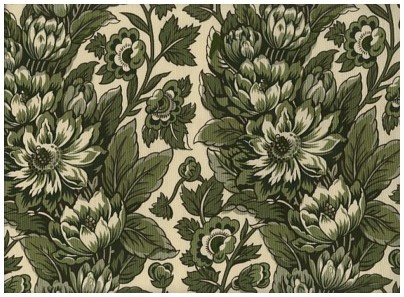
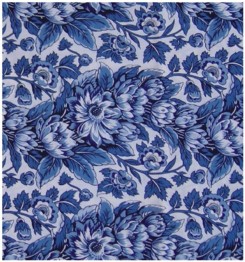 |
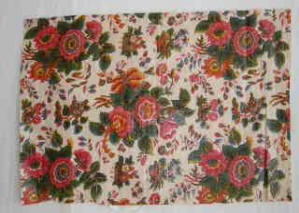
original early 19th Century
chintz |
|
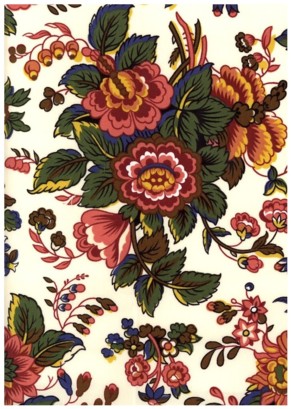
Bunches of flowers decorate this chintz print. there are two different large
bouquets and smaller flower bunches in the open areas. this style of chintz was
popular in the 1830s in England. This design could be made with block or a
roller printer. Pencilling of yellow dye onto the leaves is portrayed on the
reproduction. |
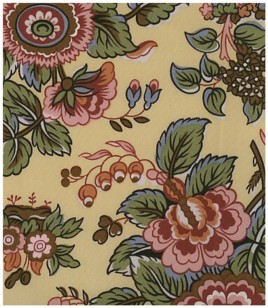
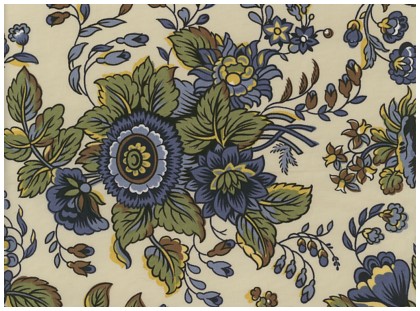
_____________________________________
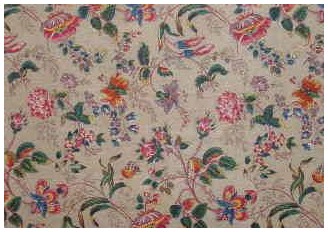
original early 19th Century chintz
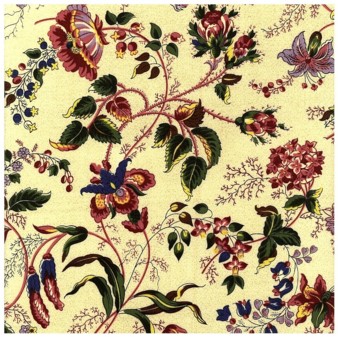 A
more airy and delicate chintz than the first two is called a floral spray on a
patterned ground. With the improvements of roller printing came finely patterned
grounds, tiny all-over patterns were placed behind most chintz prints now that
it was possible to do. 1815 would be the earliest you would see this in a roller
print, but block printers also patterned their grounds by placing pins and
narrow strips of metal into the wood block. This floral spray has a French feel,
and it stands out from the English ones. They blend nicely together in one
quilt, but each stands on its own and will not get lost within one quilt. A
more airy and delicate chintz than the first two is called a floral spray on a
patterned ground. With the improvements of roller printing came finely patterned
grounds, tiny all-over patterns were placed behind most chintz prints now that
it was possible to do. 1815 would be the earliest you would see this in a roller
print, but block printers also patterned their grounds by placing pins and
narrow strips of metal into the wood block. This floral spray has a French feel,
and it stands out from the English ones. They blend nicely together in one
quilt, but each stands on its own and will not get lost within one quilt.
_____________________________________
Go to page two: Pat L. Nichols III
|